Understanding NHS pay bands is essential for healthcare professionals, HR teams, and job seekers aiming to work within the UK’s National Health Service.
As one of the largest public sector employers in the UK, the NHS uses a structured salary system to ensure fair pay across various roles. This guide breaks down everything you need to know about NHS pay bands, salary structures, progression routes, and the latest updates for 2025.
What Are NHS Pay Bands?
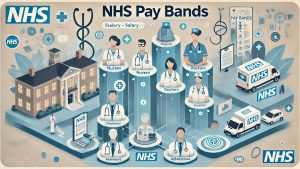
NHS pay bands are a structured salary system used to ensure fair and consistent pay across the UK’s National Health Service. They reflect the responsibilities, qualifications, and experience of both clinical and non-clinical staff.
This structure is governed by the Agenda for Change (AfC) framework, introduced in 2004 to standardise pay across England, Wales, and Northern Ireland (Scotland uses a closely related system with some local variations).
The pay bands range from Band 1 to Band 9, though Band 1 has been phased out for new roles. These bands help categorise jobs across a wide range of professions from porters and clerical assistants to nurses, therapists, and senior managers.
Each job role is evaluated and placed into a band based on factors such as:
- The level of responsibility and decision making
- Required qualifications and training
- Physical and emotional demands of the role
- Working environment (e.g. patient-facing vs. office-based)
How Do NHS Pay Bands Work?

The functionality of NHS pay bands is underpinned by pay points and progression mechanisms within each band. These elements reward employees for loyalty, performance, and professional development.
Here’s how the system works:
1. Band Levels and Job Role
Each role is assigned a specific band depending on the duties and level of responsibility. For example:
- Band 2: Healthcare Assistants, Clerical Officers
- Band 5: Newly qualified Nurses, Physiotherapists
- Band 8a–8d: Senior Managers, Department Heads
- Band 9: Executive-level Directors
2. Pay Points
Each band contains pay points (also called spine points) that represent incremental salary steps. A staff member begins on the first point and progresses to higher points with time and satisfactory performance.
3. Annual Increments
Most NHS employees receive yearly increments within their pay band until they reach the top of that band. This automatic progression is usually conditional upon:
- Meeting performance targets during annual appraisals
- Completing relevant training or CPD (Continuing Professional Development)
- Remaining in post without major disciplinary issues
How Is the NHS Salary Structure Organised in 2024?
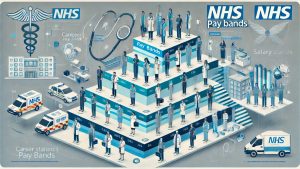
As of the 2024–2025 financial year, the NHS salary structure continues to follow the principles of the Agenda for Change but reflects updated pay scales after recent government negotiations and inflation adjustments.
The basic organisation includes:
- Entry-level salaries for new starters within a band
- Intermediate pay points for experienced staff
- Top-of-band pay for those with significant tenure or responsibility
Here’s a breakdown of the structure:
| Band | Experience Level | Pay Range (2024–25) |
| Band 2 | Entry-Level Support | £22,383 – £24,336 |
| Band 3 | Senior Support | £23,159 – £25,654 |
| Band 4 | Associate Roles | £25,147 – £27,596 |
| Band 5 | Entry-Level Nurse | £28,407 – £34,581 |
| Band 6 | Specialist Roles | £35,392 – £42,618 |
| Band 7 | Advanced Practice | £43,742 – £50,056 |
| Band 8a | Managerial/Clinical | £50,952 – £57,349 |
| Band 8b | Senior Manager | £58,972 – £68,525 |
| Band 8c | Deputy Directors | £70,417 – £81,138 |
| Band 8d | Directors | £83,571 – £97,202 |
| Band 9 | Executive Roles | £99,891 – £114,949 |
What Is the NHS Agenda for Change?

The NHS Agenda for Change (AfC) is the national pay system introduced in 2004 to create a fair, transparent, and consistent framework for paying NHS staff across England, Wales, and Northern Ireland. It replaced a previously fragmented system and now applies to over 1.2 million NHS employees, with the exception of doctors, dentists, and very senior managers, who have their own pay arrangements.
At its core, the AfC sets out a system for:
- Job Evaluation: Each role is objectively assessed using a national framework that looks at the skills, responsibilities, knowledge, and effort required.
- Pay Banding: Jobs are placed into one of the nine NHS pay bands, which then determine the salary range for that role.
- Standardised Terms and Conditions: These include entitlements such as sick pay, annual leave, overtime rates, and pension contributions, ensuring uniformity across NHS trusts.
By unifying the way jobs are evaluated and compensated, the Agenda for Change aims to eliminate pay inequality, reward experience and development, and improve staff morale and retention.
How Does the NHS Agenda for Change Affect Pay?

The Agenda for Change plays a direct role in how pay is structured and managed for NHS staff. It eliminates inconsistencies between job roles and ensures that pay is linked to the value of the work performed, not subjective factors or location-specific negotiations.
AfC impacts NHS pay?
- Defines Pay Bands: Every NHS role is matched to a specific pay band (from Band 2 to Band 9), ensuring consistent salary levels for similar roles across the country.
- Structures Progression: Within each band, there are pay points that staff move through with experience and positive performance reviews, allowing salary growth over time.
- Applies Enhancements: Staff working unsocial hours, weekends, or night shifts are entitled to enhanced pay as per AfC agreements.
- Protects Against Pay Disparity: By using national job evaluation tools, AfC reduces the risk of gender pay gaps, regional inequalities, and role misclassification.
- Improves Transparency: Employees know what to expect in terms of starting salary, pay progression, and promotional opportunities.
The system also undergoes regular review by the NHS Pay Review Body, which makes annual recommendations on pay increases, based on inflation, government budgets, and workforce needs.
In 2025, the AfC continues to be a pillar of NHS workforce policy, supporting fair pay practices in a constantly evolving healthcare environment.
How Much Do NHS Staff Earn in Each Pay Band?

Salaries within each band vary depending on experience and location (such as high-cost area supplements for London).
Let’s look at examples:
- Band 2: Healthcare assistants and receptionists, starting at £22,383
- Band 5: Newly qualified nurses, starting at £28,407
- Band 6: Senior nurses or therapists, up to £42,618
- Band 8b–9: Senior management roles, with salaries approaching or exceeding £100,000
How Does Progression Within NHS Pay Bands Work?

NHS employees typically progress within their pay band through annual increments until they reach the top of the band. This is based on:
- Length of service
- Performance and appraisals
- Meeting required competencies
Progression can also occur between bands, often through promotions or completing further qualifications. For example, a nurse might move from Band 5 to Band 6 by taking on a specialist role.
What Are the Differences Between Band 5, Band 6 and Band 7 NHS Roles?
These three bands are among the most common clinical grades and show a clear career path for healthcare professionals:
| NHS Band | Typical Role | Salary Range (2024–25) | Key Responsibilities |
| NHS Band 5 | Staff Nurse, Radiographer | £28,407 – £34,581 | Clinical care, assessments |
| NHS Band 6 | Specialist Nurse, Senior Physio | £35,392 – £42,618 | Leadership, complex cases |
| NHS Band 7 | Advanced Nurse Practitioner | £43,742 – £50,056 | Clinical lead, service management |
These levels also involve increased responsibility, qualifications (such as postgraduate degrees), and leadership expectations.
How Can You Use the NHS Pay Calculator to Estimate Your Earnings?
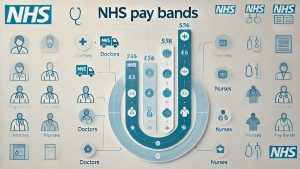
The NHS Pay Calculator is a free online tool that allows staff and applicants to estimate their pay, including:
- Gross and net pay
- Tax and National Insurance deductions
- Pension contributions
- Location-specific adjustments
It’s particularly useful for new applicants trying to assess what salary to expect based on the role and region.
Popular calculators include:
- NHS Employers’ Pay Calculator
- Third-party tools like nhspay.org or nurses.co.uk
What Are the Latest NHS Pay Rise Updates in the UK?

The NHS underwent a pay review in 2024, and the government implemented a 5% pay increase for most AfC staff as part of a negotiated settlement with unions. This follows strikes and widespread dissatisfaction in 2022–2023.
Key updates include:
- Additional one-off payments to support with the cost of living
- Increased starting salaries across most bands
- Review of working conditions and progression criteria
In 2025, further reviews are underway, and updates are expected later in the year via the NHS Pay Review Body.
How Do NHS Roles and Responsibilities Influence Pay Bands?

Job responsibilities directly affect where a role sits within the NHS pay band structure. A few examples:
- Administrative staff (Band 2–4) handle clerical and operational duties.
- Clinical support workers (Band 3–4) assist in care delivery.
- Registered nurses and allied health professionals (Band 5–7) manage patient care.
- Managers and executives (Band 8–9) oversee service delivery and strategic planning.
Taking on more complex duties, certifications, or managerial tasks typically results in promotion to a higher band.
Table: NHS Pay Bands Breakdown with Salary Ranges and Roles
| Band | Common Roles | Salary Range (2024–25) |
| Band 2 | Healthcare Assistant, Clerk | £22,383 – £24,336 |
| Band 3 | Senior HCA, Admin Officer | £23,159 – £25,654 |
| Band 4 | Associate Practitioner, Medical Secretary | £25,147 – £27,596 |
| Band 5 | Staff Nurse, Radiographer | £28,407 – £34,581 |
| Band 6 | Specialist Nurse, Social Worker | £35,392 – £42,618 |
| Band 7 | Advanced Nurse Practitioner, Team Manager | £43,742 – £50,056 |
| Band 8a–8d | Matron, Department Lead, Director | £50,952 – £97,202 |
| Band 9 | Chief Executive, Board-Level Executive | £99,891 – £114,949 |
How Do NHS Pay Bands Compare to Private Healthcare Salaries in the UK?

For healthcare professionals considering a career in the UK, understanding how NHS pay bands compare to private healthcare salaries is essential. While the NHS offers a well-defined and transparent pay structure, private healthcare can vary widely depending on the employer, location, and job role.
Differences Between NHS and Private Sector Pay
| Criteria | NHS Pay Bands | Private Healthcare |
| Salary Structure | Standardised (Agenda for Change) | Variable (negotiated) |
| Job Security | High | Moderate |
| Pension Scheme | Generous NHS Pension | Often limited or optional |
| Overtime/Unsocial Hours Pay | Paid according to national rules | May not be paid |
| Training & CPD | Fully funded in most cases | May depend on employer |
| Career Progression | Structured with defined roles | Can be faster but less structured |
While private roles (e.g. consultants in BUPA or Spire) may offer higher base pay, they often lack the benefits, pension security, and progression structure found in the NHS. Additionally, private facilities may not provide the same level of support for career development or continued education.
For most healthcare workers especially those early in their careers the NHS remains the preferred employer due to its clear salary bands, long-term job security, and comprehensive benefits.
What Are the Pension and Benefits Included in NHS Pay Bands?

Beyond base salary, NHS staff benefit from one of the most generous public sector packages in the UK. These non monetary perks play a major role in making NHS roles more attractive and sustainable over the long term.
NHS Pension Scheme (2025 Updates)
- Based on Career Average Revalued Earnings (CARE)
- Employees contribute between 5.1% and 14.5% of salary
- Employers contribute 20.6% on top
- Pension includes a lump sum and annual income after retirement
- Includes death in service and ill health retirement benefits
Annual Leave Entitlements
| Years of Service | Annual Leave |
| 0–5 years | 27 days + bank holidays |
| 5–10 years | 29 days + bank holidays |
| 10+ years | 33 days + bank holidays |
Other Benefits Include
- Sick Pay: Full pay up to 6 months, depending on service
- Maternity & Paternity Pay: Generous schemes with up to 52 weeks’ leave
- Flexible Working: Part-time, job sharing, hybrid roles increasingly available
- Career Development: Funded training and CPD opportunities
- Wellbeing Support: Access to NHS mental health and staff support programmes
These benefits are included across all NHS pay bands, making them a major incentive to remain within the public system, even if salaries may appear lower compared to the private sector.
How Will NHS Pay Bands Be Affected by Inflation and Economic Changes in 2025?
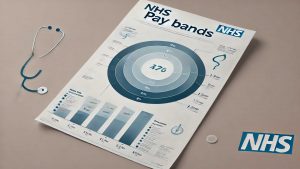
With inflation and economic instability affecting nearly every sector in the UK, NHS pay remains a key issue for healthcare workers in 2025. After a turbulent few years marked by strikes and funding debates, there are both challenges and improvements emerging this year.
Current Economic Climate (Q1 2025)
- UK inflation has moderated to 3.1%, down from peaks in 2022–2023
- Public sector wage growth is under pressure from budget constraints
- Healthcare unions are pushing for real-term pay increases
Likely Impacts on NHS Pay Bands
- Incremental increases are still in place for most bands
- Annual cost of living adjustments may continue if inflation rises again
- Discussions with the NHS Pay Review Body are ongoing in 2025
- A further one-off bonus may be issued later in the year to address staff retention
Long-Term Considerations
- Rising costs may erode the value of lower bands (e.g., Band 2–4)
- Senior NHS staff may see smaller relative increases due to capped top-level pay
- Pension contributions and thresholds may be reviewed for future sustainability
In short, while NHS pay bands remain stable and structured, economic changes continue to challenge their real-world value. It’s vital for NHS professionals to stay updated with annual reviews and union announcements.
Conclusion
NHS pay bands offer a transparent and structured way to understand salaries and career progression within the UK’s healthcare system. Whether you’re starting a new role or planning your professional development, understanding how pay bands, increments, and roles align can help you make informed decisions.
In 2025, NHS pay structures continue to evolve with rising expectations around fair compensation, cost of living support, and improved working conditions. Staying updated with official NHS pay reviews and using tools like pay calculators can provide a strategic advantage for career growth.
Frequently Asked Questions About NHS Pay Bands
How often are NHS pay bands updated?
NHS pay bands are typically reviewed annually, often influenced by the NHS Pay Review Body and government budget decisions.
Are London NHS staff paid more?
Yes, London-based NHS employees receive a High Cost Area Supplement of 5% to 20% depending on their location.
Can agency staff access the same NHS pay bands?
Agency staff do not follow the Agenda for Change bands but may negotiate comparable rates depending on the contract.
What’s the starting salary for a Band 5 nurse?
In 2024–25, a newly qualified Band 5 nurse earns £28,407, excluding overtime and location supplements.
Do NHS pay bands apply in Scotland?
Yes, though Scotland uses its own version of Agenda for Change with slightly different pay rates and conditions.
What is the role of the NHS Pay Review Body?
The NHS PRB advises the government on pay for NHS staff under Agenda for Change, using evidence from unions and employers.
Can you move between bands without changing jobs?
In some roles, yes. If you take on more responsibilities or gain qualifications, you may be eligible for band progression even within the same role.








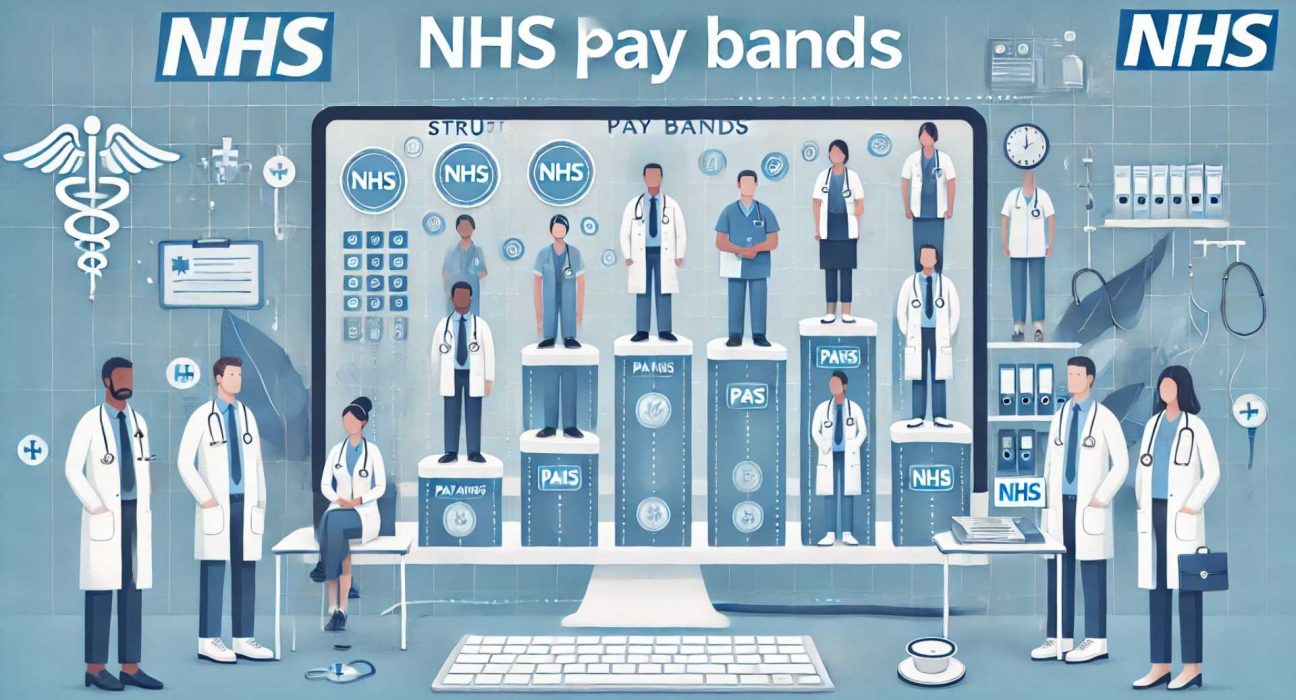
Leave feedback about this